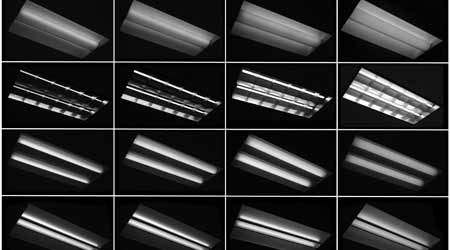 Tubular LEDs with narrow or wide beam spreads may alter appearance and light distribution. In these photos, the camera’s lens was adjusted to highlight differences; all fixtures are brighter than shown. The image is from CALiPER report 21.2, “Linear (T8) LED Lamp Performance in Five Types of Recessed Troffers.”Courtesy of Pacific Northwest National Laboratory, CALiPER Report 21.2, May 2014
Tubular LEDs with narrow or wide beam spreads may alter appearance and light distribution. In these photos, the camera’s lens was adjusted to highlight differences; all fixtures are brighter than shown. The image is from CALiPER report 21.2, “Linear (T8) LED Lamp Performance in Five Types of Recessed Troffers.”Courtesy of Pacific Northwest National Laboratory, CALiPER Report 21.2, May 20148 Tips For Selecting Tubular LEDs
Use these helpful hints and selection guides for choosing the right TLEDs
1. Ballast factor (BF) tells us (relative to a standard of 1.0) how much light will be emitted by lamps powered at that factor. A BF of .88 (common for electronic ballasts) will cause a standard 4-foot T8 fluorescent lamp to emit about 2500 lumens. A low-power ballast (BF = .78) will use fewer watts, but slightly dims the lamp. TLEDs may operate properly at low BFs, but (like fluorescents) may emit fewer lumens. If a proposed TLED will use an existing ballast, verify its brightness is sufficient before bulk purchasing.
2. Power quality (i.e., power factor and total harmonic distortion) of LED drivers is generally close to that of electronic ballasts (e.g., power factor greater than .9, total harmonic distortion less than 15 percent) but spec sheets should be checked.
3. Glare is high light intensity where you don’t want it. Unlike a fluorescent lamp that glows evenly across its cylindrical surface, bright LED chips are visible in clear-tubed TLEDs. Depending on the type of fixture (lensed or open), facility use, fixture mounting height, and work surfaces, glare may not be an issue. But in locations with smooth and shiny surfaces, those “hot spots” may create a distraction if lamps are visible inside fixtures. Many TLEDs are available with fully or partially frosted bulbs.
4. CRI (Color Rendering Index) describes (on a scale of 0-100) how accurately light renders colors of surfaces, relative to sunlight. Like T8 and T5 fluorescents, nearly all LED systems offer CRI of at least 80.
5. CCT (Correlated Color Temperature) uses the Kelvin temperature scale of 0-10,000 to measure the color emanating from the lamps. Like fluorescents, LED white light is a mix of colors at various intensities. “Warmer” colors (i.e., rich in yellow-orange) have lower CCT, while “cooler” colors (rich in blue-violet) have higher CCT. While both fluorescents and many TLEDs are available in a wide CCT range, some TLED brands offer only 4000 or 5000 K. Efficacy drops slightly with CCT. Units having the same CCT from different manufacturers may look different: Field test with sample units to ensure acceptability.
6. Some TLEDs (e.g., those without well-known brand names) lack internal circuitry protecting against arcing from faulty wiring, ballast failure, or a power surge. Better units sense such issues, shutting them off until the problem is fixed (instead of just burning out). Warranties may, however, be voided if a custodian “hot swaps” a TLED.
7. While internal temperatures of most fixtures are relatively low, some enclosed and gasketed units, such as those used in wet locations, may contain all the heat from a ballast and lamps. Lifetimes of LED drivers and circuitry may be shortened if exposed to fixture temperatures above 140 F. For locations like the ceiling of a hot factory or in direct sunlight in a hot climate, check the specs and warranty of a proposed TLED. At least one manufacturer will not honor its warranty if its units are installed in a fully enclosed fixture.
8. While not a technical concern, some customers check specs for “made in USA” or “BAA” (i.e., “Buy America Act”) to express procurement preferences.
Selection guides for LEDs
Three federally-supported programs make choosing LED options easier:
• CALiPER reports compare types of LED units against each other and standard light sources. Download them at http://energy.gov/eere/ssl/caliper-testing.
• The U.S. Department of Energy’s Lighting Facts Label (www.lightingfacts.com/) tests LED systems, providing a standardized way to compare their various lighting and operating characteristics. That program also lists LED kits and fixtures that meet them. As of December 2016, it no longer lists or archives TLED replacement lamps.
• DesignLights Consortium (DLC) builds off the Lighting Facts program by providing specs for many LED devices (fixtures, retrofit kits, and lamps). DLC maintains listings of TLEDs of which it has approved at https://www.designlights.org/search/. Find DLC definitions of TLEDs and other types of approved units here. DLC is a non-profit organization supported by state, regional, and utility energy efficiency programs throughout the United States and Canada.
In the past, customers used the Energy Star branding program to choose high-efficiency light sources. While still a valid source of information, Energy Star does not test devices, and its specs for LED devices may be looser and less complete than those of DLC.
Author's note: LED technology continues to advance rapidly. Before applying any of lessons in this article, check out the specs for several brands and types of LED retrofits and new fixtures. New/better options (including better controls, longer warranties, easier installation) continue to appear. Avoid buying "old" LED equipment that may cost a tad less but lack better options. Remember: what you install today may last 15 to 20 years.
Lindsay Audin, CEM, LEED AP, CEP, is president of EnergyWiz, an energy consulting firm based in Croton, N.Y. He is a contributing editor for Building Operating Management.
Email comments and questions to edward.sullivan@tradepress.com.
TLED flicker: an app for that
Flicker (expressed as a percent) was an issue with some early low-quality TLED units. While flicker is not quantified by DOE’s Lighting Facts Label, few (if any) of today’s units have flicker exceeding that of electronically-ballasted fluorescents. If dimming is an option, check for flicker across the full range of existing (or planned) dimmers. Even when imperceptible to most of us, too much flicker may cause fatigue and severe headaches for some people. In the old days, we checked flicker using a spinning top; watch it at www.envisionlightingdesign.com/blog/flicker-checker-once-for-magnetic-ballasts-now-for-led. That site also shows how to use a smart phone camera to do so. There’s even an app for that.
Related Topics:













